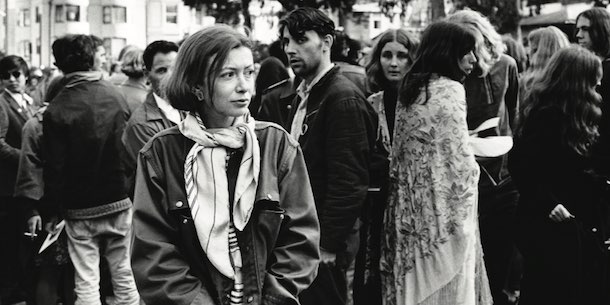Slouching Towards Bethlehem
We forget all too soon the things we thought we could never forget. We forget the loves and the betrayals alike, forget what we whispered and what we screamed, forget who we were.

Named after the William Butler Yeats poem The Second Coming, Slouching Towards Bethlehem is Joan Didion’s first collection of 20 essays that reflects on the social and cultural movements of the 60s. While the title references one of the essays in the collection (deemed one of her best works), Didion covers her perspective of counter culture in the 60s while hinting at the slow collapse of society.
As per my last review of The White Album, Didion continues (or in this case precedes) what she did best in The White Album. She unravels the intricate social and cultural idiosyncrasies of the era. In many of her essays, pervasive cynicism in American politics is carefully woven in. Didion’s writing captures the atmosphere in a way that a dozen movies/documentaries could altogether.
In the opening piece Some Dreamers of the Golden Dream, Didion vividly paints the picture of the superficial suburban despair in chase of the American Dream. By following the case of a marital murder, she exposes the moral decay of the era and juxtaposes the gender roles. This essay also foreshadows Didion’s recurring exploration of media sensationalism. In the subsequent essay, Didion openly acknowledges her fixation on the constructed image of John Wayne and explores how her perception of him shows her own enthrallment of American strength. In another essay, Didion embarks on a quest to uncover the meaning of journaling, even as she grapples with the inherent inaccuracies that may permeate her notes.
The longest piece is the titled Slouching Towards Bethlehem, where Didion covers the Haight-Ashbury district of San Francisco during the hippie movement revolving around the Summer of Love. She writes:
The stories are endless, infinitely familiar, traded by the faithful like baseball cards, fondled until they fray around the edges and blur into the apocryphal.
Didion exposes the hidden complexities of this era. She delves into the disillusionment experienced by the ‘lost children’ and the folly of their idealistic pursuits that drew them to the district. She reports on the communal living, the rebellion, and the drug use, particularly the prevalence of drugs like LSD and the optimism, chaos, and unravelling it all brought. As a frequent visitor of the Haight-Ashbury district, her examination of the counter culture zeitgeist was captivating.
In the last essay Goodbye to All That, Didion meditates on her eight years in New York City, a place that she loved and loathed - the city wherein she lost herself.
…quite simply, I was in love with New York. I do not mean “love” in any colloquial way, I mean that I was in love with the city, the way you love the first person who ever touches you and you never love anyone quite that way again. I remember walking across Sixty-second Street one twilight that first spring, or the second spring, they were all alike for a while. I was late to meet someone but I stopped at Lexington Avenue and bought a peach and stood on the corner eating it and knew that I had come out out of the West and reached the mirage.
The way she summarizes her time in New York was the conclusion that I came up with near the end of my graduation. The lost promises, the sunsets between the Avenues, the energy amongst the crowds - it felt as if I was reliving my time there. The evolution of her character, the critical moment of realization, was just perfect.
In Joan Didion’s experiences, I often find a mirror to my journey. While the specific events that shaped her time and mine differ drastically, her perspective resonates deeply with my own experiences in California and New York. What’s truly incredible is that each essay really fits the overall theme of Yeats’ haunting poem that it was named after. She perfectly describes the gradual buildup of societal turmoil. These stories thread not only her experiences together, but serve as timeline of the evolving American landscape - a testament to her literature.
The darkness drops again but now I know, we loved with a love that was more than love, that twenty centuries of stony sleep, were vexed to nightmare by a rocking cradle, and what rough beast, its hour come round at last, slouches towards Bethlehem to be born?
Overall Rating: 8/10
Afterthought: I’m quite honestly scared to continue reading, because I know there is a point where it all ends. Its made me realize how fragile life is (in sort of a beautiful way?)
